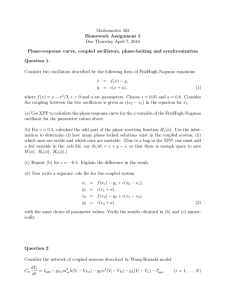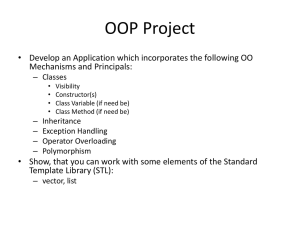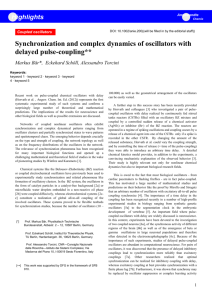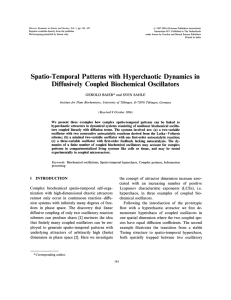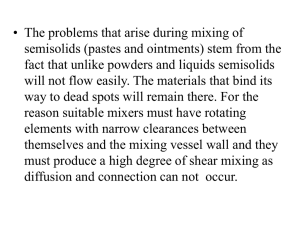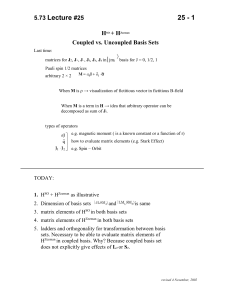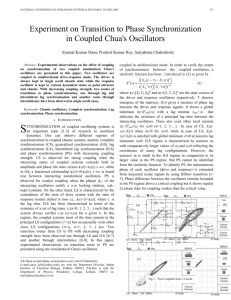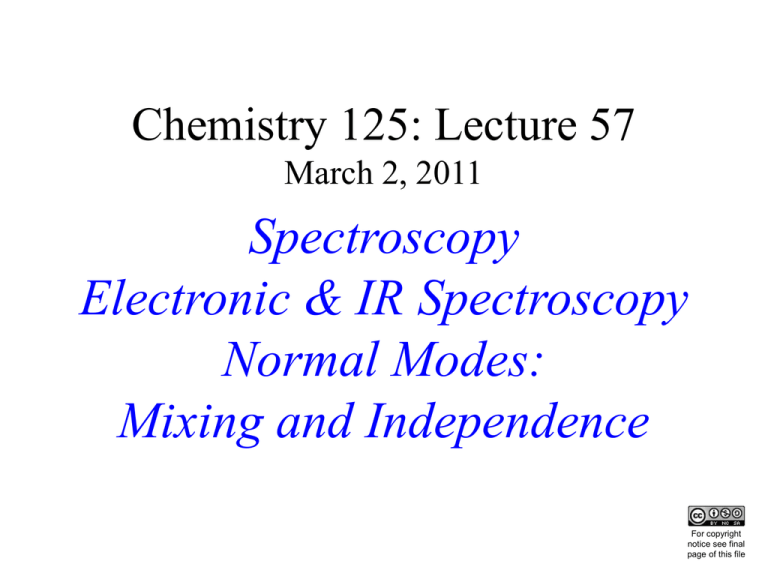
Chemistry 125: Lecture 57
March 2, 2011
Spectroscopy
Electronic & IR Spectroscopy
Normal Modes:
Mixing and Independence
This
For copyright
notice see final
page of this file
Spectroscopy for
Structure and Dynamics
Electronic (Visible/UV)
Vibrational (Infrared)
NMR (Radio)
e.g. F&J sec. 12.7-12.8 pp. 533
e.g. F&J sec. 15.4, pp. 707-713
e.g. F&J sec. 15.5-15.9, pp. 713-749
O.E.D.
“Specters or straunge Sights, Visions and Apparitions” (1605)
“Sunbeams..passing through a Glass Prism to the opposite
Wall, exhibited there a Spectrum of divers colours”
Newton (1674)
“Atom in a Box”
can be used to show:
(1) Spectral transitions for H atom (levels, energy, wavelength)
(2) Static shift of e-density from mixing 2s with 2p (same energy)
(3) Oscillation of e-density from mixing orbitals with different energy
because of change in relative phase* with time (add, then subtract).
(a) Oscillating “dipole” from mixing 1s with 2p.
(makes or interacts with light)
(b) “Breathing” from mixing 1s with 2s.
(no interaction with light)
* This is a feature of time-dependent quantum mechanics, where the (complex)
phase of a wavefunction changes at a rate proportional to its energy. When
energies of the components differ, their relative phases vary in time.
1s
2p
+
time-dependent
(1s + 2p)2
superposition e-density
Oscillation frequency
given by the energy
difference between 1s
and 2p
+
+
Time-Dependence Footnote
cos
A time-dependent wavefunction looks just like the spatial
s we have been talking about, except that it is multiplied
by eit = cos(t) + i sin(t), where i = (-1), is the energy (in
frequency units) of the spatial wavefunction and t is time.
In many cases this makes no difference, because when you
“square” the wave function you get eit e-it = 2.
BUT when a problem involves actually* mixing two states
of different energy, one considers a wavefunction of the form
eit + eit . If 1 and 2 are different, this means that
the two spatial functions cycle in- and out-of-phase with one
another. If at a certain time they add, at a time 0.5/(1-2)
later they will subtract. e.g. (1s+2pz) will become (1s-2pz).
time This is the source of the oscillation we observe when
superimposing functions of different n using Atom-in-a-Box.
*
This is different from the mixing involved in forming hybrids or LCAO-MOs,
where we just try to guess the best shape for an orbital of one particular energy
for a molecule by analogy with known solutions for a simpler situation (atoms).
1s
2p
+
time-dependent
(1s + 2p)2
superposition e-density
Oscillation frequency
given by the energy
difference between 1s
and 2p
+
+
Oscillating dipole has
“oscillator strength”
interacts with /
generates / absorbs
light
1s - 2p transition
is “allowed”
1s
2s
+
time-dependent
(1s + 2s)2
superposition e-density
Pulsing frequency
given by the energy
difference between 1s
and 2s
+
+
Symmetrical “breathing”
e-density deformation has
no “oscillator strength”
does not interact
with light’s E-field.
1s - 2s transition
is “forbidden”
n-* Transitions of
Organic “Chromophores”
-
+
n+*
C X :
+
-
n-*
Oscillating electric
field wags electrons
up and down by
mixing n with *.
The large energy gap between n and *
makes this transition occur at high
frequency (in the ultraviolet).
n-* Transitions of
Organic “Chromophores”
* mix approaches energy of 2p orbital
+
+
-
-
-
+
C X :
-
-
+
+
+
-
n-*
Oscillating electric
field wags electrons
up and down by
mixing n with *.
With sufficient “conjugation” the *
LUMO energy shifts close enough to n
that the transition is at visible wavelength.
e.g. the retinaldehyde imine
of rhodopsin, which is the
R visual pigment in our eyes.
-Carotenyne
H2 Pd/Pb
H
H
C C
During work on the synthesis
of Vitamin-A
-Carotene
R
OPP catalystOPP
OPP
Palladium-Lead
wasRdeveloped, with which
PPO
a
hn D
one can hydrogenate a triple
bond without attacking
H
R
double bonds already present
in
the starting material
C C
H
R
or those created by the hydrogenation.
Helvetica Chimica Acta, 35, 447 (1952)
with kind permission of Lloyd Spitalnik
©Birdwatchers Digest
Autumn
Summer
Scarlet(?)
Scarlet(!) Tanager
Early Fall
O:
conjugated
isolated
O
retinal
canthaxanthin
isozeaxanthin
-carotene
Graph of a Spectrum (IR of Paxil)
(1) Light
Intensity
(2) LightInduced
Overlap
(3) Light’s
“Handle”
(changing dipole)
Meaning
of Axes :
(1) Experiment
(2) Quantum Mechanics
(1) Color (wavelength)
(3) Classical Mechanics
(3) Molecular Vibration Frequency
(2) Molecular Energy Gap
Infrared Spectroscopy
Using Light to Fingerprint molecules,
molecules ,
to identify Functional Groups,,,,,,,
and to use molecular dynamics
to study Bonding and whether
Atoms are linked by “Springs”
.
What Makes Vibration Sinusoidal?
2
(half) amplitude
d
x
2
x h sin(t)
a h sin(t)
2 acceleration
displacement
frequency
dt
a
dx
2
h cos(t)
dt
x
velocity
F m
Newton a -fx
Hooke
F = - fx
f
m
2
a f
2
x m
f
m
Frequency
Constant!
independent of
amplitude 2h
(Text Fig12.6)
Hooke, of Spring (1678)
Frequency
Constant!
independent of
amplitude 2h
Harrison’s Marine Chronometer (1761)
© National Maritime Museum, Greenwich, London
For atoms
f should be
Bond Stiffness.
(1, 2, 3?)
C-H sqrt (1/0.9) ~3000/cm ; 1014Hz
C-O sqrt (1/6.9) ~1100 ~3 x1013
When Hooke’s Law (Cf. Eyring)
C=O sqrtApplies:
(2/6.9) ~1500
C=N sqrt (3/6.5) ~1900
√m
f
Frequency
H-C =
1 12
1 + 12
C-C =
12 12 Quartz Crystal Microbalance
= 6.0
can weigh a monolayer
12 + 12
C-O =
12 16
12 + 16
= 0.9
H-X stands apart
of adhering molecules
=(e.g.
6.9 H + H C=CH / Pt)
2
2
2
m is mass
or, for free diatomic, “reduced” mass
12 35
C-Cl = 12 + 35 = 8.9
=
m1 m2
m1 + m2
is dominated by the smaller mass!
Coupled Oscillators
illustrate:
Complexity
“Normal” mode analysis
Phase of mixing
Possibility of effective independence
Coupled Oscillators
Simple
2 = f/m
Coupled Oscillators
Simple
2 = f/m
Coupled to
Frozen Partner
2 = (f +s)/m
Coupled Oscillators
Simple
2 = f/m
Coupled to
Frozen Partner
2 = (f +s)/m
In-Phase
Coupling
2 = 2f/2m
= f/m
Coupled Oscillators
Simple
2 = f/m
coupled
oop
Coupled to
Frozen Partner
2 = (f +s)/m
ip
In-Phase
Coupling
2 = 2f/2m
= f/m
isolated
•
In such
“Normal”
Modes
all atoms
oscillate at Out-of-Phase Coupling
2 = 2(f +2s)/2m
the same
= (f +2s)/m
frequency
Coupled Oscillators
ip
oop
oop + ip
Superposition of
Two Normal Modes of
different frequency
Vibration switches between
oscillators as the two modes
beat in- and out-of-phase
In-Phase
Coupling
2 = 2f/2m
= f/m
In such
“Normal”
Modes
all atoms
oscillate at Out-of-Phase Coupling
2 = 2(f +2s)/2m
the same
= (f +2s)/m
frequency
Very Different Oscillators are ~Independent
oop
ip
oop
+ ip
Vibration remains localized
when coupling is weak
compared to -mismatch
coupled
oop
high
low
ip
A General Molecule of N Atoms has
3N Independent Geometric Parameters.
(e.g. as Cartesian Coordinates)
or
3 to Fix Center of Mass
3 to Fix Orientation
3N-6 for Internal Vibrations
(Normal Modes)
3N-6 Mixed-up Normal Modes
sounds hopelessly complex.
(though good for “fingerprint”)
but
mixing requires:
Frequency Match
&
Coupling Mechanism
(Cf. Energy-match / Overlap)
coupled
oop
isolated
ip
Butane C4H10
3 x (4 + 10) = 42 degrees of freedom
- 3 (translation) - 3 (rotation) = 36 vibrations
C4 : 3 stretch, 2 bend, 1 twist
10 C-H : 10 stretch, 20 bend or twist
Mixed (according to frequency-match / coupling) into 36 normal modes.
Timing has been disabled on this slide so you can step back
C
Straight
Chain
Hydrocarbons
8
and forth with the arrow keys to study vibrational modes.
“Breathing”
gives no net
E(t)
E(t)helps
helpspush
push
dipole
change
- no IR peak
48Hs
H in
up
and
andout
down
Half of
C-H
C-H
C-CH3 CH2
CH2
CH2
C4H10’s ten stretch
stretch
scissors umbrella wag
rock
C-H stretch
+ C-C stretch
Octane
normal modes
have no “handle” C8H18 26 atoms 72 normal modes (not all IR active)
End of Lecture 57
March 2, 2011
Copyright © J. M. McBride 2011. Some rights reserved. Except for cited third-party materials, and those used by visiting
speakers, all content is licensed under a Creative Commons License (Attribution-NonCommercial-ShareAlike 3.0).
Use of this content constitutes your acceptance of the noted license and the terms and conditions of use.
Materials from Wikimedia Commons are denoted by the symbol
.
Third party materials may be subject to additional intellectual property notices, information, or restrictions.
The following attribution may be used when reusing material that is not identified as third-party content:
J. M. McBride, Chem 125. License: Creative Commons BY-NC-SA 3.0

